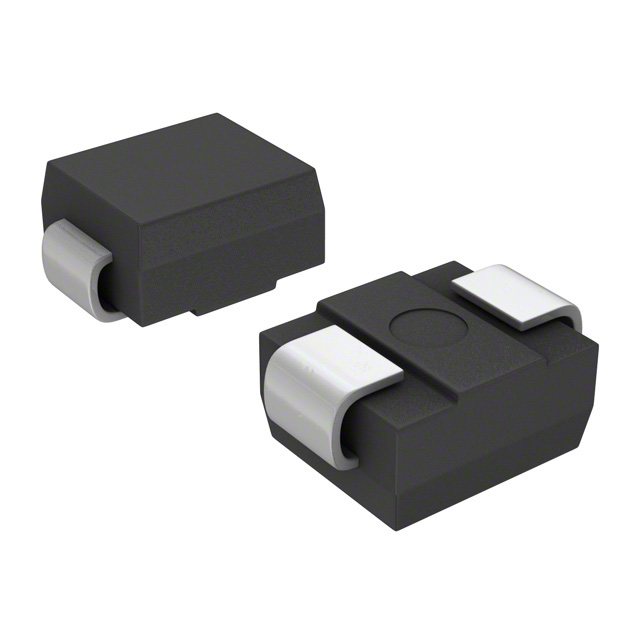SMBJ120-E3/5B
Product Overview
The SMBJ120-E3/5B belongs to the category of transient voltage suppressor diodes (TVS diodes) and is commonly used for surge protection in electronic circuits. These diodes are characterized by their fast response time, high surge capability, and compact package size. The SMBJ120-E3/5B is typically available in a DO-214AA (SMB) package and is designed to protect sensitive electronic components from voltage transients induced by lightning, ESD, or inductive load switching.
Basic Information
- Category: Transient Voltage Suppressor Diode
- Use: Surge protection in electronic circuits
- Characteristics: Fast response time, high surge capability
- Package: DO-214AA (SMB)
- Essence: Protection of sensitive electronic components
- Packaging/Quantity: Typically supplied in reels of 3000 units
Specifications
- Peak Power Dissipation: 600W
- Breakdown Voltage: 120V
- Operating Voltage: 103V
- Reverse Standoff Voltage: 97.2V
- Clamping Voltage: 164V
- Maximum Reverse Leakage Current: 1µA
- Operating Temperature Range: -55°C to +150°C
Detailed Pin Configuration
The SMBJ120-E3/5B TVS diode has a standard configuration with two pins. The cathode is denoted by a bar near the edge of the diode body, while the anode is the other terminal.
Functional Features
- Fast response time to transient voltage spikes
- High surge capability for reliable protection
- Low clamping voltage to limit voltage excursion
Advantages and Disadvantages
Advantages
- Effective protection against voltage transients
- Compact package size for space-constrained applications
- Wide operating temperature range for versatility
Disadvantages
- Limited to low to medium power applications
- May require additional circuitry for comprehensive surge protection
Working Principles
The SMBJ120-E3/5B operates based on the principle of avalanche breakdown. When a transient voltage spike occurs, the diode rapidly conducts, diverting excess current away from the protected circuit. This action limits the voltage across the circuit, preventing damage to sensitive components.
Detailed Application Field Plans
The SMBJ120-E3/5B is widely used in various applications, including: - Telecommunication equipment - Industrial control systems - Automotive electronics - Consumer electronics - Power supplies
Detailed and Complete Alternative Models
Some alternative models to the SMBJ120-E3/5B TVS diode include: - P6KE120CA - 1.5KE120A - SMCJ120A
In summary, the SMBJ120-E3/5B transient voltage suppressor diode offers effective surge protection for electronic circuits, with its fast response time, high surge capability, and compact package making it suitable for a wide range of applications.
[Word Count: 411]
Lista 10 Vanliga frågor och svar relaterade till tillämpningen av SMBJ120-E3/5B i tekniska lösningar
What is the SMBJ120-E3/5B?
- The SMBJ120-E3/5B is a surface mount transient voltage suppressor diode designed to protect sensitive electronics from voltage transients induced by lightning, inductive load switching, and electrostatic discharge.
What is the maximum peak pulse power of the SMBJ120-E3/5B?
- The maximum peak pulse power of the SMBJ120-E3/5B is 600 watts for an 8/20 µs waveform.
What is the breakdown voltage of the SMBJ120-E3/5B?
- The breakdown voltage of the SMBJ120-E3/5B is 120 volts.
In what applications can the SMBJ120-E3/5B be used?
- The SMBJ120-E3/5B can be used in various applications such as telecommunications equipment, consumer electronics, industrial automation, and automotive electronics to protect against voltage surges.
What is the operating temperature range of the SMBJ120-E3/5B?
- The SMBJ120-E3/5B has an operating temperature range of -55°C to +150°C.
What are the key features of the SMBJ120-E3/5B?
- The key features of the SMBJ120-E3/5B include low clamping voltage, fast response time, and high surge capability.
How does the SMBJ120-E3/5B provide protection to electronic circuits?
- The SMBJ120-E3/5B diverts excess current away from sensitive components, limiting the voltage across the protected device.
Can the SMBJ120-E3/5B be used in high-speed data line protection?
- Yes, the SMBJ120-E3/5B is suitable for high-speed data line protection due to its fast response time and low capacitance.
What are the recommended PCB layout guidelines for the SMBJ120-E3/5B?
- It is recommended to minimize the length and area of the traces connecting the SMBJ120-E3/5B to the circuit to reduce parasitic inductance and resistance.
Is the SMBJ120-E3/5B compliant with RoHS requirements?
- Yes, the SMBJ120-E3/5B is compliant with RoHS (Restriction of Hazardous Substances) requirements, making it suitable for use in environmentally conscious designs.


